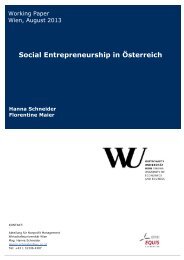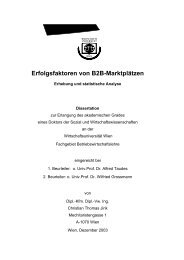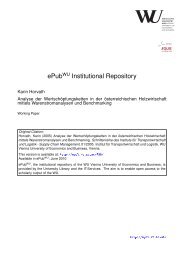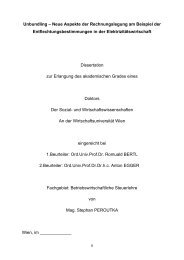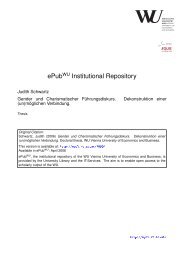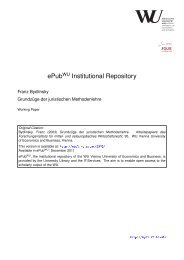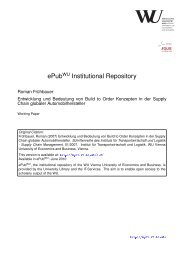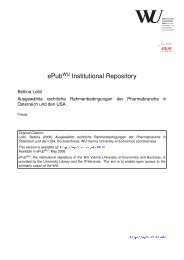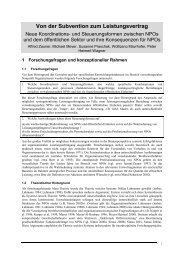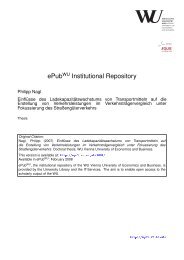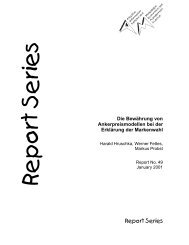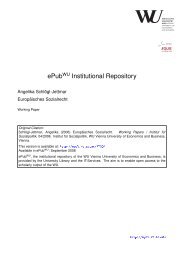Download - ePub WU
Download - ePub WU
Download - ePub WU
You also want an ePaper? Increase the reach of your titles
YUMPU automatically turns print PDFs into web optimized ePapers that Google loves.
652 JOURNAL OF CONSUMER RESEARCH<br />
et al. 1994, 1996; Goldenberg et al. 2008; Myers and Robertson<br />
1972; Venkatraman 1989). Knowledgeable and influential<br />
consumers have also been conceptualized and operational<br />
ized as "market mavens" (Feick and Price 1987).<br />
We incorporated all tbree characteristics of opinion leadership<br />
into a concise 3-indicator scale for children. A Cronbach's<br />
alpha of .79 showed that the internal consistency of<br />
the three indicators was sufficiently high. Therefore, the<br />
indicators were combined into a single scale for opinion<br />
leadership. Confirmatory factor analysis revealed a good<br />
overall fit (GFI = .93; IFI = .93; CFI = .92). In addition,<br />
all three indicators loaded positively and statistically significantly<br />
on opinion leadership (/J< .01), thus pointing to<br />
a satisfactory level of convergent validity.<br />
Self-reported measures are often criticized in the literature<br />
on adults, mainly with the argument that some people are<br />
unable to report their performance accurately due to poor<br />
introspection (Locke, Latham, and Erez 1988). However,<br />
there are also many studies that use self-reported measures<br />
and achieve high levels of accuracy (Cooper 1981). In addition,<br />
there are concepts that can hardly be measured objectively,<br />
for example, "individual creativity" (Leenders. van<br />
Engelen, and Kratzer 2007). This is also tbe case witb tbe<br />
concepts of lead usemess and opinion leadership. Throughout<br />
tbe literature, the measurement of lead usemess and<br />
opinion leadership is widely based on self-reported values.<br />
We tbus adapted our measurements to existing operationaiizations<br />
and used self-reported values. Moreover, there is<br />
evidence that self-ratings correlate highly with more "objective"<br />
measures in cases wbere anonymity is assured. In<br />
particular, Heneman (1974) found tbat self-reported measures<br />
were less restricted in range and leniency than tbe<br />
purportedly more objective ratings. Accordingly, we also<br />
promi.sed anonymity in our study. In addition, Corey (1971)<br />
and Tittle and Hill ( 1967) argue that the error arising from<br />
self-reporting techniques is minor. In fact, our results enable<br />
a clear classification along tbe dimensions of lead userness<br />
and opinion leadership. As shown below, we also find<br />
roughly the same association between lead userness and<br />
opinion leadership (table I ; r = 0.34) as that reported in<br />
prior studies on adults (Morrison et al. 2000; Schreier et ai.<br />
2007).<br />
Control Variable.^, There are many other factors that<br />
have been shown to influence (or that may influence) behavioral<br />
effects witbin social networks. While it is not possible<br />
to include all other variables in tbis study, we chose<br />
to include two variables that have demonstrated the most<br />
prominent effect on tbe social networks of children. First.<br />
we included gender because males and females express and<br />
satisfy their needs and feelings differently (Del Vecchio<br />
2002). In addition, Kalmijn (2003) reports that gender influences<br />
social networks because females are likely to bave<br />
more frequent contact witb friends than males do. This variable<br />
is included as a dummy, where male = 0 and female<br />
= I. Second, we included age because children of different<br />
ages have differing likes and dislikes and because children's<br />
thoughts, expectations, and feelings change as tbey grow<br />
older (John and Lakshmi-Ratan 1992). In addition, research<br />
shows that social networks are not stable over time. Stages<br />
in the course of an actor's life will also influence his or her<br />
social networks (Kalmijn 2003).<br />
Analytical Techniques<br />
In order to test hypotheses 1 and 2, we used hierarchical<br />
linear modeling (HLM). This method has its origins in research<br />
performed at schools, which are also the setting of<br />
this study, but many organizational pbenomena (e.g., the<br />
behavior of individuals within teams) also occur as hierarchically<br />
ordered systems, with variables of interest residing<br />
at different levels of analysis (Hoffman, Griffin, and<br />
Gavin 2000). The HLM methodology is particularly well<br />
suited for analyzing hierarchically nested data structures<br />
where micro-level observations (i.e., individuals) are nested<br />
within macro-level observations (i.e., scbool classes/teams;<br />
Bryk and Raudenbush 1992). Hierarcbical linear modeling<br />
explicitly recognizes that individuals within school classes/<br />
teams may be more similar to eacb other than to individuals<br />
in other school classes/teams and therefore may not provide<br />
independent observations (Hoffman et al. 2000). In order<br />
to test wbetber the observations are indeed nested in scbool<br />
classes, we calculated tbe intraclass correlation coefficients<br />
(ICCs) for lead userness and opinion leadersbip. The results<br />
show a moderate ICC for lead usemess (.64) and opinion<br />
TABLE 1<br />
DESCRIPTIVE STATISTICS AND CORRELATION COEFFICIENTS<br />
Variable Mean SD<br />
1. Lead user<br />
2. Opinion leader<br />
3. Gender<br />
4. Age<br />
5. Degree centrality<br />
6. Closeness centrality<br />
7. Betweenness centrality<br />
3.12<br />
2.93<br />
.53<br />
8.76<br />
39.17<br />
25.60<br />
16.30<br />
.45<br />
.88<br />
.51<br />
1.31<br />
10.76<br />
8.33<br />
19.75<br />
.34" 17"<br />
09-<br />
.25"<br />
.12-<br />
-.11"<br />
.09-<br />
.59"<br />
.02<br />
.21"<br />
.23"<br />
.32"<br />
-.09-<br />
.11-<br />
.37"<br />
.61<br />
.22<br />
.06<br />
.17<br />
.41<br />
.39<br />
NOTE.—W= 519.<br />
•p



